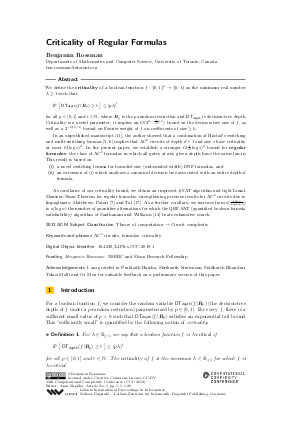Criticality of Regular Formulas
Author Benjamin Rossman
-
Part of:
Volume:
34th Computational Complexity Conference (CCC 2019)
Part of: Series: Leibniz International Proceedings in Informatics (LIPIcs)
Part of: Conference: Computational Complexity Conference (CCC) - License:
 Creative Commons Attribution 3.0 Unported license
Creative Commons Attribution 3.0 Unported license
- Publication Date: 2019-07-16
File

PDF
LIPIcs.CCC.2019.1.pdf
- Filesize: 0.67 MB
- 28 pages
Document Identifiers
Subject Classification
ACM Subject Classification
- Theory of computation → Circuit complexity
Keywords
- AC^0 circuits
- formulas
- criticality
Metrics
- Access Statistics
-
Total Accesses (updated on a weekly basis)
0PDF Downloads0Metadata Views
Abstract
We define the criticality of a boolean function f : {0,1}^n -> {0,1} as the minimum real number lambda >= 1 such that Pr [DT_{depth}(f|R_p) >= t] <= (p lambda)^t for all p in [0,1] and t in N, where R_p is the p-random restriction and DT_{depth} is decision-tree depth. Criticality is a useful parameter: it implies an O(2^((1- 1/(2 lambda))n)) bound on the decision-tree size of f, as well as a 2^{-Omega(k/lambda)} bound on Fourier weight of f on coefficients of size >= k.
In an unpublished manuscript [Rossmann, 2018], the author showed that a combination of Håstad’s switching and multi-switching lemmas [Håstad, 1986; Håstad, 2014] implies that AC^0 circuits of depth d+1 and size s have criticality at most O(log s)^d. In the present paper, we establish a stronger O(1/d log s)^d bound for regular formulas: the class of AC^0 formulas in which all gates at any given depth have the same fan-in. This result is based on
(i) a novel switching lemma for bounded size (unbounded width) DNF formulas, and
(ii) an extension of (i) which analyzes a canonical decision tree associated with an entire depth-d formula.
As corollaries of our criticality bound, we obtain an improved #SAT algorithm and tight Linial-Mansour-Nisan Theorem for regular formulas, strengthening previous results for AC^0 circuits due to Impagliazzo, Matthews, Paturi [Impagliazzo et al., 2012] and Tal [Tal, 2017]. As a further corollary, we increase from o(log n /(log log n)) to o(log n) the number of quantifier alternations for which the QBF-SAT (quantified boolean formula satisfiability) algorithm of Santhanam and Williams [Santhanam and Williams, 2014] beats exhaustive search.
Cite As Get BibTex
Benjamin Rossman. Criticality of Regular Formulas. In 34th Computational Complexity Conference (CCC 2019). Leibniz International Proceedings in Informatics (LIPIcs), Volume 137, pp. 1:1-1:28, Schloss Dagstuhl – Leibniz-Zentrum für Informatik (2019)
https://doi.org/10.4230/LIPIcs.CCC.2019.1
BibTex
@InProceedings{rossman:LIPIcs.CCC.2019.1,
author = {Rossman, Benjamin},
title = {{Criticality of Regular Formulas}},
booktitle = {34th Computational Complexity Conference (CCC 2019)},
pages = {1:1--1:28},
series = {Leibniz International Proceedings in Informatics (LIPIcs)},
ISBN = {978-3-95977-116-0},
ISSN = {1868-8969},
year = {2019},
volume = {137},
editor = {Shpilka, Amir},
publisher = {Schloss Dagstuhl -- Leibniz-Zentrum f{\"u}r Informatik},
address = {Dagstuhl, Germany},
URL = {https://drops.dagstuhl.de/entities/document/10.4230/LIPIcs.CCC.2019.1},
URN = {urn:nbn:de:0030-drops-108230},
doi = {10.4230/LIPIcs.CCC.2019.1},
annote = {Keywords: AC^0 circuits, formulas, criticality}
}
Author Details
Funding
- Rossman, Benjamin: NSERC and Sloan Research Fellowship
Acknowledgements
I am grateful to Prahladh Harsha, Shrikanth Srinivasan, Siddharth Bhandari, Tulasi Molli and Or Meir for valuable feedback on a preliminary version of this paper.
References
-
Kazuyuki Amano. Tight Bounds on the Average Sensitivity of k-CNF. Theory of Computing, 7(1):45-48, 2011.

-
Paul Beame. A switching lemma primer. Technical report, Technical Report UW-CSE-95-07-01, Department of Computer Science and Engineering, University of Washington, 1994.

-
Paul Beame, Russell Impagliazzo, and Srikanth Srinivasan. Approximating AC⁰ by Small Height Decision Trees and a Deterministic Algorithm for #AC⁰-SAT. In 27th Annual IEEE Conference on Computational Complexity, pages 117-125, 2012.

-
Ravi B Boppana. The average sensitivity of bounded-depth circuits. Information processing letters, 63(5):257-261, 1997.

-
Johan Håstad. Almost optimal lower bounds for small depth circuits. In Proceedings of the 18th Annual ACM Symposium on Theory of Computing, pages 6-20. ACM, 1986.

-
Johan Håstad. On the correlation of parity and small-depth circuits. SIAM Journal on Computing, 43(5):1699-1708, 2014.

-
Russell Impagliazzo, William Matthews, and Ramamohan Paturi. A satisfiability algorithm for AC⁰. In Proceedings of the 23rd Annual ACM-SIAM Symposium on Discrete Algorithms, pages 961-972. SIAM, 2012.

- Nathan Keller and Noam Lifshitz. Approximation of biased Boolean functions of small total influence by DNF’s. arXiv preprint, 2017. URL: http://arxiv.org/abs/1703.10116.
-
Nathan Linial, Yishay Mansour, and Noam Nisan. Constant depth circuits, Fourier transform, and learnability. Journal of the ACM, 40(3):607-620, 1993.

-
Alexander A Razborov. An equivalence between second order bounded domain bounded arithmetic and first order bounded arithmetic, 1993.

-
Benjamin Rossman. An entropy proof of the switching lemma and tight bounds on the decision-tree size of AC⁰ circuits.

-
Benjamin Rossman. The average sensitivity of bounded-depth formulas. Computational Complexity, 27(2):209-223, 2018.

-
Benjamin Rossman and Srikanth Srinivasan. Separation of AC⁰[⊕] Formulas and Circuits. In LIPIcs-Leibniz International Proceedings in Informatics, volume 80. Schloss Dagstuhl-Leibniz-Zentrum fuer Informatik, 2017.

-
Rahul Santhanam and Ryan Williams. Beating exhaustive search for quantified boolean formulas and connections to circuit complexity. In Proceedings of the Twenty-Sixth Annual ACM-SIAM Symposium on Discrete Algorithms, pages 231-241. SIAM, 2014.

-
Dominik Scheder and Li-Yang Tan. On the average sensitivity and density of k-CNF formulas. In Approximation, Randomization, and Combinatorial Optimization. Algorithms and Techniques, pages 683-698. Springer, 2013.

-
Avishay Tal. Shrinkage of De Morgan formulae by spectral techniques. In 55th Annual IEEE Symposium on Foundations of Computer Science, pages 551-560, 2014.

-
Avishay Tal. Tight bounds on the Fourier spectrum of AC⁰. In LIPIcs-Leibniz International Proceedings in Informatics, volume 79. Schloss Dagstuhl-Leibniz-Zentrum fuer Informatik, 2017.

-
Patrick Traxler. Variable Influences in Conjunctive Normal Forms. In Theory and Applications of Satisfiability Testing-SAT 2009: 12th International Conference, SAT 2009, Swansea, UK, June 30-July 3, 2009. Proceedings, volume 5584, page 101. Springer, 2009.

-
Andre M. Zubkov and Aleksandr A. Serov. A complete proof of universal inequalities for the distribution function of the binomial law. Theory of Probability & Its Applications, 57(3):539-544, 2013.

